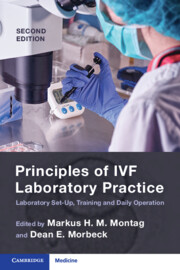Book contents
- Principles of IVF Laboratory Practice
- Principles of IVF Laboratory Practice
- Copyright page
- Contents
- Contributors
- Foreword
- The Evolution of IVF Practice
- Section 1 Starting a New Laboratory and Training Protocols
- Section 2 Pre-procedure Protocols
- Section 3 Gametes
- Section 4 Insemination/ICSI
- Section 5 Fertilization Assessment
- Chapter 28 Fertilization Assessment in IVF and ICSI
- Section 6 Embryo Assessment: Morphology and Beyond
- Section 7 Embryo Cryopreservation
- Section 8 Embryo Transfer
- Section 9 Quality Management
- Index
- References
Chapter 28 - Fertilization Assessment in IVF and ICSI
from Section 5 - Fertilization Assessment
Published online by Cambridge University Press: 07 August 2023
- Principles of IVF Laboratory Practice
- Principles of IVF Laboratory Practice
- Copyright page
- Contents
- Contributors
- Foreword
- The Evolution of IVF Practice
- Section 1 Starting a New Laboratory and Training Protocols
- Section 2 Pre-procedure Protocols
- Section 3 Gametes
- Section 4 Insemination/ICSI
- Section 5 Fertilization Assessment
- Chapter 28 Fertilization Assessment in IVF and ICSI
- Section 6 Embryo Assessment: Morphology and Beyond
- Section 7 Embryo Cryopreservation
- Section 8 Embryo Transfer
- Section 9 Quality Management
- Index
- References
Summary
Selection of the best embryo to transfer, that is, the one that will have the highest potential to result in a live birth, is one of the most important decisions in an in vitro fertilization (IVF) laboratory. A zygote forms with the amalgamation of the female and male gametes, and much information about the viability of an embryo can be gained within 16 to 20 hours after insemination. Interaction of the oocyte and sperm should first be examined with an accurate assessment of fertilization.
Keywords
- Type
- Chapter
- Information
- Principles of IVF Laboratory PracticeLaboratory Set-Up, Training and Daily Operation, pp. 207 - 212Publisher: Cambridge University PressPrint publication year: 2023
References
- 2
- Cited by

